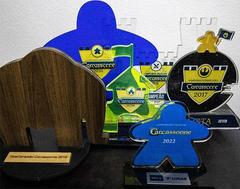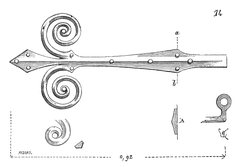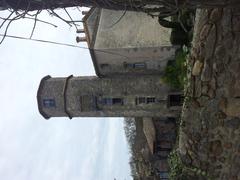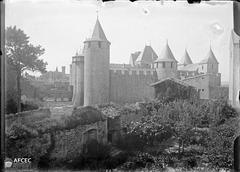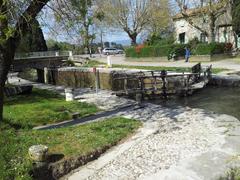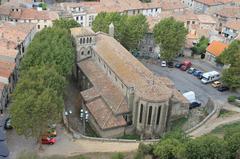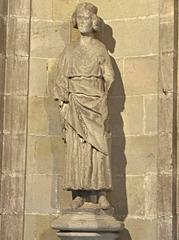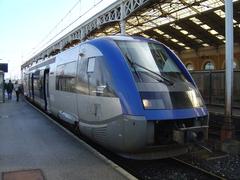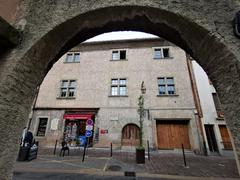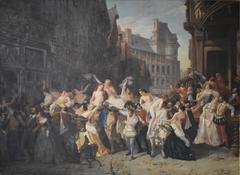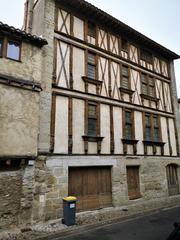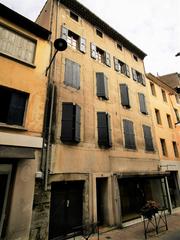
Halles de Carcassonne: Visiting Hours, Tickets, and Comprehensive Visitor Guide
Date: 14/06/2025
Introduction
Nestled in the vibrant Bastide Saint-Louis district of Carcassonne, France, the Halles de Carcassonne—formally known as Halles Prosper Montagné—stands as a testament to the city’s rich heritage and enduring community spirit. This iconic covered market, with origins in the 18th and 19th centuries, seamlessly blends historical architecture with the lively pulse of Occitan gastronomy. Whether you’re seeking artisanal cheeses, the region’s famed cassoulet, or a glimpse into Carcassonne’s daily life, the Halles offers a unique and immersive experience for every visitor (monumentum.fr; carcassonne.org; Tourisme Carcassonne; Trip101).
This guide provides a thorough overview—including visiting hours, ticketing, accessibility, practical tips, and the Halles’ architectural and cultural significance—to help you make the most of your visit to this beloved Carcassonne landmark.
Table of Contents
- Origins and Historical Evolution
- Architectural Features
- Cultural Significance
- Market Offerings and Local Specialties
- Visitor Information
- Special Events, Tours, and Photographic Spots
- Nearby Attractions
- Sustainability and Community Impact
- FAQs
- Tips for a Memorable Visit
- Conclusion
- References and Further Reading
Origins and Historical Evolution
The Birth of Covered Markets in Carcassonne
After Carcassonne’s expansion beyond its medieval citadel in the 13th century, the need for organized, hygienic marketplaces became apparent. By the 18th century, French cities began constructing covered markets to address public health, sanitation, and urban modernization. The Halles de Carcassonne emerged as a prime example, replacing prior open-air markets and embodying Enlightenment ideals in its design and civic purpose (carcassonne.org; Britannica).
Naming and Heritage
Named after Prosper Montagné, the celebrated Carcassonne-born chef and author of the first Larousse gastronomique, the Halles pays tribute to the city’s deep culinary roots and its ongoing commitment to regional gastronomy (Tourisme Carcassonne).
Architectural Features
Design and Construction
Completed in the late 18th century and modified in the 19th, the Halles de Carcassonne reflects the era’s advances in both architecture and public health. Its iron-and-glass construction, open arcades, and large windows provide ample natural light and ventilation, ensuring a pleasant shopping experience year-round (monumentum.fr).
Key features include:
- Rectangular, open-plan layout for efficient circulation.
- Robust iron columns supporting the roof and maximizing open space.
- Natural stone and glass elements enhancing both durability and aesthetic appeal.
- Classical detailing such as pilasters and cornices, lending the building a dignified presence (carcassonne.org).
Urban Integration and Preservation
Strategically positioned near Place Carnot, the Halles anchors the commercial and social life of Bastide Saint-Louis. Designated a Monument Historique in 1948, it benefits from ongoing preservation, ensuring its architectural integrity for future generations (monumentum.fr).
Cultural Significance
The Halles is much more than a market—it is a vibrant social center and a guardian of Occitan identity. Here, locals and visitors mingle amid stalls brimming with fresh produce, regional specialties, and Languedoc wines. The market is also a hub for community events, culinary workshops, and festivals celebrating Occitan language, music, and traditions (Carcassonne Castle; Tourisme Carcassonne).
Market Offerings and Local Specialties
Explore a bounty of regional products:
- Seasonal fruits and vegetables from local farms
- Artisanal cheeses (e.g., Cabécou, Tomme de Pyrénées)
- Charcuterie including sausages, pâtés, and cured meats
- Fresh breads and pastries
- Mediterranean seafood and high-quality meats
- Ready-to-eat dishes like cassoulet—Carcassonne’s iconic bean and meat stew
- Local wines and spirits, especially from the renowned Languedoc region (Go Languedoc)
Most vendors gladly offer tastings and are happy to share preparation tips and stories behind their products.
Visitor Information
Location and Getting There
- Address: Rue de Verdun, Bastide Saint-Louis, 11000 Carcassonne
- By Foot: Easily walkable from most areas in Ville Basse and about 20–25 minutes from the medieval Cité
- By Public Transport: Agglo Carcassonne buses stop at Place Carnot, a short walk from the Halles
- By Car: Public parking is available nearby (e.g., Gambetta lot); early arrival is advised on market days (Petit Futé)
Opening Hours and Admission
- Days: Tuesday to Sunday (closed Monday)
- Hours: Typically 7:00 AM to 1:00 PM (may vary slightly by season)
- Entry: Free; no tickets or reservations required (Trip101)
Facilities and Accessibility
- Wheelchair-friendly entrances and wide aisles
- Nearby public restrooms
- Communal seating areas for enjoying purchases
- On-site bar serving coffee and snacks until lunchtime
Special Events, Tours, and Photographic Spots
- Events: Seasonal food festivals, wine tastings, and Occitan cultural celebrations enliven the Halles throughout the year (Tourisme Carcassonne)
- Guided Tours: Available through the Carcassonne tourist office and local agencies, highlighting market history and gastronomy
- Photographic Highlights: Capture the iron-and-glass architecture, bustling stalls, and vibrant produce displays—mornings offer the best natural light
Nearby Attractions
- Place Carnot: Carcassonne’s main square with cafés and a lively open-air market three days a week
- Bastide Saint-Louis: Historic district featuring shops, bakeries, and picturesque streets
- Canal du Midi: UNESCO-listed canal, perfect for scenic walks or picnics
- Medieval Cité de Carcassonne: World-renowned fortress and ramparts, just a short walk or bus ride away (Culture Activities)
Sustainability and Community Impact
The Halles supports local agriculture and small businesses, fostering direct relationships between producers and consumers. Visitors are encouraged to bring reusable bags, opt for seasonal and local items, and minimize waste, contributing to the market’s mission of sustainability.
FAQs
What are the Halles de Carcassonne opening hours?
Tuesday to Sunday, typically 7:00 AM to 1:00 PM. Closed Monday.
Is there an entry fee?
No, entry to the Halles is free.
Are guided tours offered?
Yes, through the local tourist office or private agencies.
Are pets allowed?
Small pets on leashes are generally permitted, but always check with individual vendors.
Is the market accessible for wheelchair users?
Yes, with flat entrances and wide aisles.
What are the best days to visit?
Saturdays are most vibrant and busy; weekdays offer a quieter experience.
Tips for a Memorable Visit
- Arrive early for the freshest products and liveliest atmosphere.
- Bring cash; while cards are increasingly accepted, some stalls are cash-only.
- Greet vendors with a friendly “Bonjour!”—it goes a long way.
- Sample before buying—vendors often offer tastings.
- Use reusable bags to support sustainability.
- Pair your visit with a stroll through Bastide Saint-Louis or a trip to the medieval Cité.
Conclusion
The Halles de Carcassonne is a living symbol of the city’s gastronomy, architectural charm, and community vitality. Whether you are a history enthusiast, foodie, or casual traveler, a visit to the Halles immerses you in the sights, sounds, and flavors that define Carcassonne and the wider Occitanie region. Plan your visit, explore nearby attractions, and embrace this vibrant slice of southern France.
For up-to-date schedules, event listings, and guided tours, download the Audiala app and follow us on social media. Explore our related articles for more on Carcassonne’s historical sites and local markets.
References and Further Reading
- Halles de Carcassonne - Monumentum.fr
- Carcassonne.org - Enlightenment Century and the Halles
- Tourisme Carcassonne - Markets
- Trip101 - Reasons to Visit Carcassonne
- Petit Futé - Halles Prosper Montagné
- Carcassonne Castle - About Carcassonne
- Tourisme Carcassonne - Agenda
- Go Languedoc - Carcassonne Tourist Information
- Culture Activities - Carcassonne Attractions
- Winalist - Visiting Carcassonne

